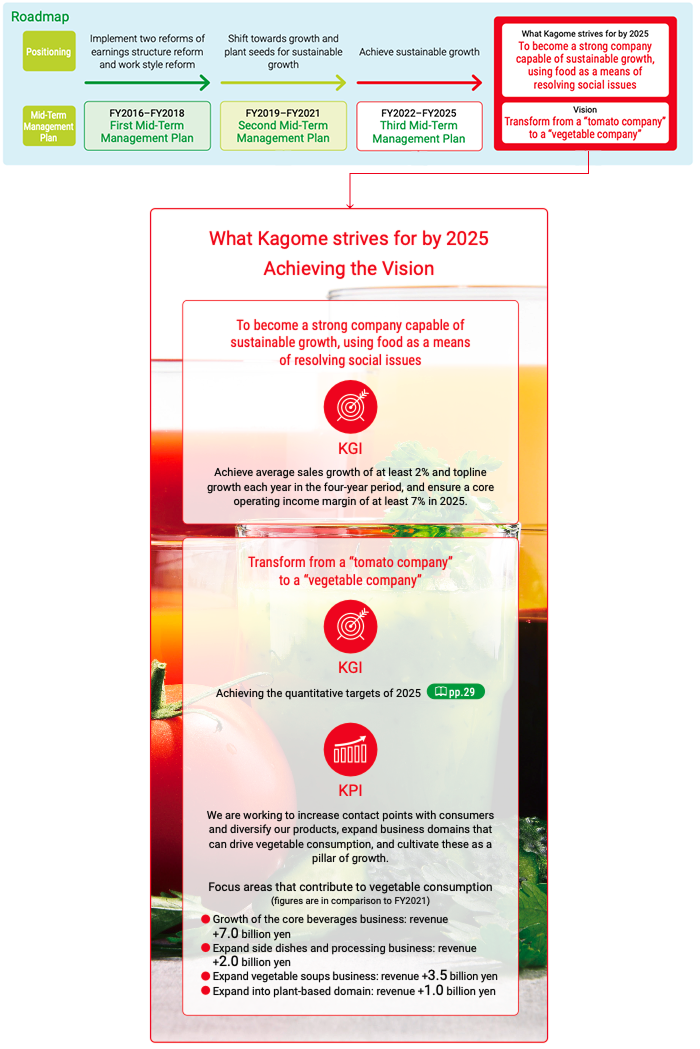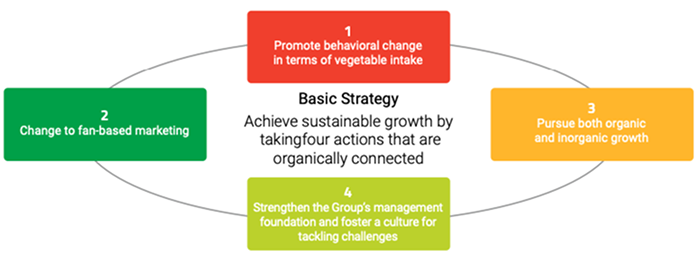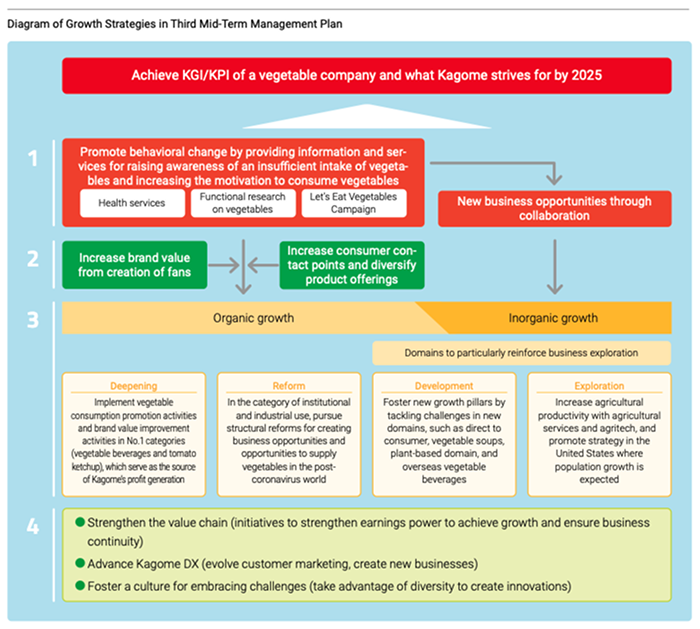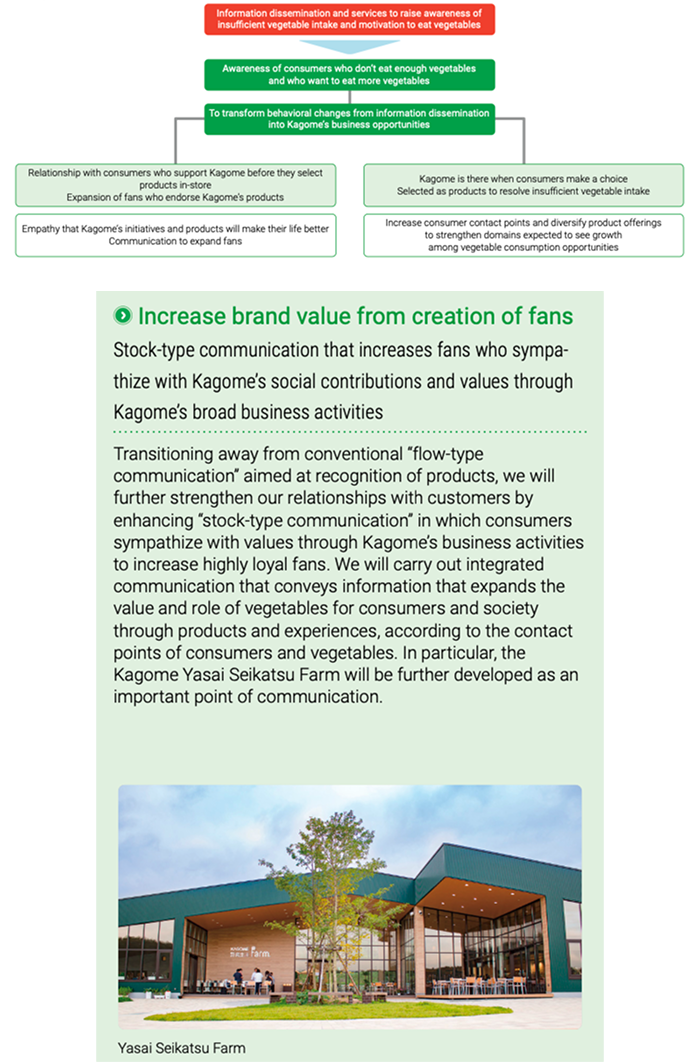Medium-term Management Plan
Kagome’s Vision and Growth Strategies
Kagome considers its brand statement “True to Nature, the Flavor of Kagome” to be a promise to customers and contributes to the realization of people’s healthy diets through the development and delivery of products that benefit from the value of nature’s bounty.
What Kagome strives for by 2025 Achieving the Vision
The third Mid-Term Management Plan, which starts in FY2022, will be a four-year plan aimed at reaching the targets of 2025.

The Mid-Term Management Plan Overview
We have positioned the four years from 2022 to 2025 as our third Mid-Term Management Plan aimed at achieving what Kagome strives for by 2025 and our vision. The basic strategy is to “achieve sustainable growth by taking four actions that are organically connected.”


Promote behavioral change in terms of vegetable intake
- ● The starting point of growth strategies will be efforts toward raising consumers' awareness of an insufficient intake of vegetables and increasing their motivation to consume vegetables by providing information and health service.
- ● The Let’s Eat Vegetables Campaign, which kicked off in January 2020, serves as the core activity. It promotes awareness of insufficient intake of vegetables, the benefits of consuming vegetables, functions of vegetables, and ways to enjoy vegetables using a fun approach to encourage voluntary behavioral change in vegetable consumption.
Change to Fan-Based Marketing
- ● We will work on the two actions of “Increase brand value from creation of fans” and “Increase consumer contact points and diversify product offerings” in order to make behavioral changes toward vegetable consumption a business opportunity and growth driver.

Pursue Both Organic and Inorganic Growth
- ● We will utilize internal resources and external collaboration to achieve organic growth by growing products and services already in the portfolio. However, organic growth alone will mean we fall short of our growth needs. During the third Mid-Term Management Plan, we will also pursue inorganic growth by obtaining new resources through M&A.
Strengthen the Group’s management foundation and foster a culture for tackling challenges
- ● Strengthen the value chain
Initiatives to strengthen earnings power to support growth and enhance business continuity - ● Promote digital transformation (DX)
Accelerate DX, which is indispensable to the execution of management strategies, to support sustainable growth - ● Foster a culture that embraces challenges
Working to link diversity with innovation and increase engagement
Financial strategy in the Third Mid-Term Management Plan
Basic Policy of the Financial Strategy
It is the Group's basic policy to balance both growth investment and return of profits in our financial strategy based on a stable financial structure.
(a) Stability of the financial platform
Minimum shareholders’ equity ratio* of 50%*
Maintain Single A credit ratings
Maintaining stability of the financial platform forms the premise of sustainable growth and the ability to withstand drastic changes. The funds required for inorganic growth, including M&A, under the third Medium-Term Management Plan, are assumed to come from profits earned from organic growth and borrowing within the range of maintaining a shareholder's equity ratio of 50%. We will maintain a credit rating of single A and a minimum shareholders' equity ratio of 50% in ensuring financial stability while achieving growth through business expansion.
*Equity attributable to shareholders of the parent to total assets
(b) Growth with an emphasis on capital effiiency
ROE 9% or higher
The third Mid-Term Management Plan strives to achieve growth with an emphasis on capital efficiency. ROE is used as the KPI, an indicator that measures whether capital is being utilized efficiently. The third Mid-Term Management Plan sets a target for ROE to be 9% or higher. We aim to enhance capital efficiency while promoting agile capital policies in response to changes in the business environment.
(c) Stable return of profits
Total return ratio 40% or higher
Stable and continuous shareholder returns, acquisition of treasury stock
During the third Mid-Term Management Plan, we plan to provide stable and continuous shareholder returns so that the total return ratio reaches 40% or higher, including dividends and share buybacks. In addition, during the third Mid-Term Management Plan, we aim to pay stable dividend of at least 38 yen per share.

Kagome Environmental Management Plan
In recent years, environmental issues such as global warming and the decline of biodiversity have become urgent social issues worldwide.
The Kagome Group regards environmental initiatives as a part of its corporate social responsibility, complies with laws and regulations, and strives to prevent environmental pollution caused by its business activities. Furthermore, in response to social demands, the Group has formulated the "Kagome Environmental Management Plan" in its Third Medium-Term Management Plan (FY2022-FY2025), which incorporates issues that the Group can contribute to society, such as protecting the global environment and making effective use of resources, and has begun implementing the plan in FY2022.
| Classification | Assignment | 2025年のKPI | |
| 1. Prevention of global warming | 1) Implementing the Kagome Group's mid- to long-term greenhouse gas (GHG) reduction plan | Reducing Kagome Group's total GHG emissions to achieve carbon neutrality by 2050 |
Scope 1/2: 21% or more reduction compared to 2020 (Less than 114,000t-CO2e) |
|---|---|---|---|
|
Scope 3: 6.5% or more reduction compared to 2020 (Less than 1,230,000 t-CO2e) |
|||
| Introduction of solar power generation | Additional installation at one factory | ||
| Biomass Energy Utilization | Introduced in 2 factories | ||
| Promoting CO2 reductions at suppliers and contractors | Total volume reduced by 5.2% (compared to 2021) | ||
| Reduce CO2 emissions from logistics by 1% each year (per production volume) | >Reduce unit consumption by 4% (compared to 2021) | ||
| 2. Effective use of resources | 1) Reducing food waste from raw material procurement to product distribution | Reduce raw material waste |
Reduce raw material waste by 50% (compared to 2018, 2030 target) |
| Reduce waste of products (including work-in-progress and sales samples) |
50% reduction in product waste (compared to 2018, 2030 target) |
||
| 2) Implementation of Kagome Plastic Policy |
・Reducing the use of new plastics made from petroleum ・Promote the replacement of materials with recycled and plant-derived materials that enable resource circulation |
Eliminate the use of straws made from petroleum-based materials (target for 2030) | |
| Replace 50% or more of our materials with recycled or plant-based materials (target for 2030) | |||
| 3) Promoting resource circulation through waste recycling | Continuing zero emissions | Maintaining zero emissions | |
| Reduce food waste and maintain recycling rates | Maintain food recycling rate of 95% or higher | ||
| 3. Water Conservation | 1) Reducing water withdrawal at domestic factories | Reduce water withdrawal by 1% per year (per production volume) | Reduce unit consumption by 4% (compared to 2021) |
| 2) Promoting water purification and recycling | Compliance with local wastewater standards | Compliance with wastewater standards | |
| 3) Responses to high-risk locations (major suppliers) | Survey of major suppliers and implementation of measures | Deciding on measures for high-risk locations | |
| 4. Sustainable Agriculture | 1) Promoting sustainable agriculture both domestically and internationally | Promoting smart agriculture business | Achieving increased yields and reduced irrigation requirements (realizing low input/high output agriculture) |
| 2) Promoting sustainable raw material procurement (FSC, RSPO, etc.) | Displaying the FSC certification mark on paper containers | Displayed on all eligible products | |
| 3) Biodiversity conservation in vegetable cultivation | Development of technology to utilize indigenous natural enemies for biodiversity conservation (farms that coexist with living things) | Creating a guidebook that compiles farms that coexist with living things and the techniques verified by some of the farms | |
| 5.Improving the system | 1) Raising environmental awareness and behavior among all employees | Establishment of an environmental education system for all employees | Environmental education by department |
| Promoting company-wide environmental events | Activities carried out throughout the company and at all business locations< | ||
| 2) Establishment and continuous improvement of the Kagome Environmental Management System (KEMS) | Establishment of KEMS and continuous improvement (maintenance of ISO14001 certification) | Fewer than one re-notification in external audits | |
| 6. Communication | 1) Proactive communication to improve corporate value | Providing information to improve evaluations by institutional investors and consumers | Received an A rating in CDP climate change and water security. |
*If other target years are applicable, please indicate in the table.
Scope 1: Direct emissions of greenhouse gases by businesses themselves (fuel combustion, industrial processes)
Scope 2: Indirect emissions from the use of electricity, heat, and steam provided by other companies
Scope 3: Indirect emissions other than Scope 1 and Scope 2 (emissions by other companies related to the activities of the company)
